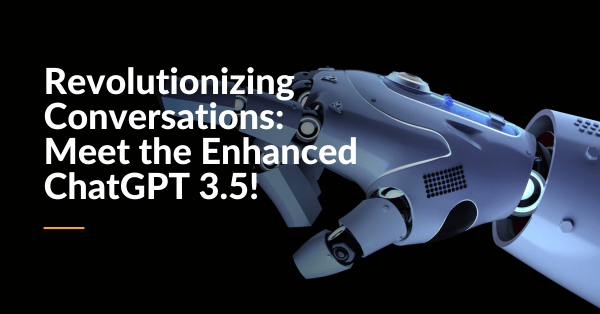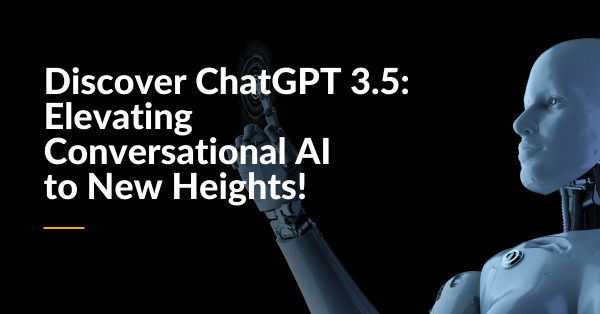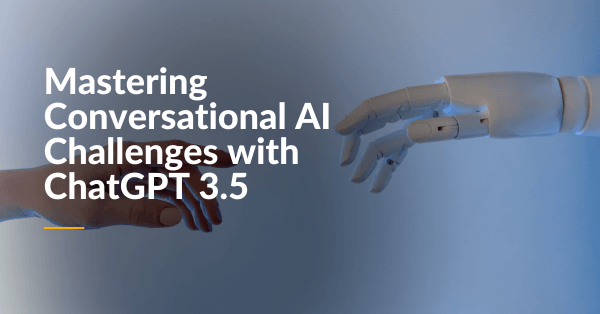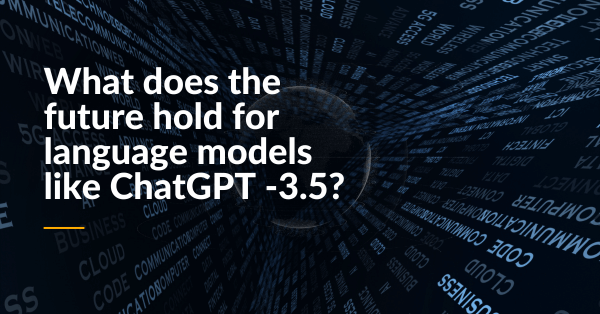It is common knowledge that we live in the era of artificial intelligence. There are several intelligent technologies that help us in our day-to-day chores. Chat GPT-3.5 is one such technology that will enhance businesses’ customer service experience. This blog will enlighten you on how chatbots can revolutionize businesses in the future.
Understanding Conversational AI
As yellow.ai mentions, conversational AI refers to the cutting-edge field that involves creating computer systems with the ability to engage in human-like and interactive conversations. It harmoniously blends innovations in the field of natural language processing, machine learning, and dialogue management to achieve highly intelligent bots for text and voice channels. By doing so, conversational AI enables computers to understand and respond to user inputs in a way that feels like they are in a conversation with another human.
Today, conversational AI is enabling businesses across industries to deliver exceptional brand experiences through a variety of channels like websites, mobile applications, messaging apps, and more! That too at scale, around the clock, and in the user’s preferred languages without spending countless hours training and hiring additional workforce. That’s not all, most conversational AI solutions also enable self-service customer support capabilities which gives users the power to get resolution at their own pace from anywhere.
No matter the size of a business, conversational AI helps them drive ROI, boost customer satisfaction and build customer loyalty through data-backed strategies, anticipation of customer needs, and hyper-personalized communications. Not just that, conversational AI also simplifies operations, elevates customer support processes, significantly improves results from marketing efforts, and ultimately contributes to a business’s overall growth and success.
The Evolution of Chat GPT-3.5:

Ts2.space has an excellent explanation of this:
GPT-1, introduced in June 2018, laid the foundation for today’s ChatGPT. It showcased the potential of unsupervised learning in language comprehension by predicting the next word in sentences using books as training data. GPT-1 was trained with 17,600 petaFLOPs.
GPT-2, released in February 2019 as a major upgrade, exhibited significant improvements in generating text and producing coherent content across multiple paragraphs. Initially withheld due to potential misuse, GPT-2 was eventually launched in November 2019 after careful risk assessment by OpenAI. GPT-2 was trained using 1.49 million petaFLOPs.
GPT-3, a groundbreaking version introduced in June 2020, marked a monumental leap forward. This advanced text generator found applications in email drafting, article writing, poetry creation, and even code generation. GPT-3 demonstrated capabilities in answering factual questions and language translation. It was trained with 314 million petaFLOPs.
Chat GPT-3.5, an improved version released in 2022, featured refined machine learning and fewer parameters compared to GPT-3. It also prioritized ethical values to ensure the AI it powers is safe and reliable. GPT-3.5 employed prompt-based learning with human feedback to enhance algorithm accuracy and effectiveness. The training resource utilization for GPT-3.5 is undisclosed, and it is offered for free by OpenAI.
The Power of Chat GPT-3.5 in Conversational AI
Chatbots have come a long way since their inception. Initially, they were basic rule-based systems that followed predefined scripts, offering little flexibility and personalization.

As technology advanced, machine learning algorithms were introduced, allowing chatbots to learn from data and improve their conversational abilities.
The advent of deep learning and transformer models like Chat GPT-3.5 has revolutionized the field of conversational AI.
These models can generate human-like responses by understanding the context and generating language that is coherent and contextually appropriate.
This has opened up new possibilities for chatbots, enabling them to handle complex inquiries and engage in more dynamic and natural conversations.
Tips for setting up a productive remote workspace
Chat GPT-3.5, or Generative Pre-trained Transformer 3.5, is the latest iteration of OpenAI’s language model.
It is trained on an enormous amount of text data, allowing it to learn the intricacies of language and generate high-quality responses.
Chat GPT-3.5 is capable of understanding and generating human-like text, making it an ideal choice for conversational AI applications.
One of the key strengths of Chat GPT-3.5 is its ability to generate coherent and contextually appropriate responses. It can understand the nuances of human language, including sarcasm, humor, and idiomatic expressions, and respond accordingly.
This makes conversations with Chat GPT-3.5 more engaging and natural, enhancing the user experience.
GPT-3.5 also exhibits impressive adaptability, allowing it to tailor its responses to individual user preferences.
It can learn from previous interactions, understand user intent, and provide personalized recommendations or assistance.
This level of customization provides users with a more satisfying and personalized experience, leading to increased engagement and customer satisfaction.
Using Chat GPT-3.5 For Customer Service:

According to techtarget, Contact center managers can use Chat GPT-3.5 to reply to customer complaints and reviews, enhance customer-facing chatbots and create virtual assistants.
1. Reply to customer complaints and reviews:
As service agents engage with customers on various channels, such as email, social media and product review websites, Chat GPT-3.5 can help them quickly formulate responses to complaints and reviews.
For example, a service agent can ask ChatGPT to write an email response to an angry customer, and the chatbot will do it — typically with the professional and empathetic tone that organizations expect their agents to use.
ChatGPT-3.5 also lets users dictate the length of responses, which can help them craft short-form responses for social media and product review comments. For instance, a user could ask ChatGPT to write them a response to a negative customer review in 500 characters or fewer.
Despite ChatGPT’s ability to generate human-like responses, users still need to edit, personalize and fact-check responses. Developers trained the tool on internet data and, therefore, it contains biases and inaccuracies that can be found online.
Additionally, this tool doesn’t have access to organizations’ specific business policies, so users must ensure responses don’t promise discounts or other forms of compensation their organizations cannot offer
2. Enhance customer-facing chatbots
Since the early 2000s, customer service departments have used customer-facing chatbots to help answer frequently asked questions, lighten agents’ workloads and reduce hiring costs. However, most have been rule-based chatbots, which offer pre-programmed responses to limited sets of keywords and phrases. These chatbots function more like a Google search than a true conversation, and natural language easily confuses them
3. Create virtual assistants:
Customer service departments can use generative AI technologies like ChatGPT to power virtual assistants for their employees.
A custom virtual assistant offers many of the same benefits as the free Chat GPT-3.5, such as email generation and summarization. However, these assistants can create more detailed answers because organizations can train them on their knowledge bases. They also offer more convenience because organizations can use APIs to embed their features directly into the tools agents work with every day.
Overcoming Challenges in Conversational AI

Integrating Chat GPT-3.5 into your business requires careful planning and execution. Here are some key considerations for implementing Chat GPT-3.5 in your business:
1. Monitoring and Evaluating:
Once Chat GPT-3.5 is implemented, it should be monitored and evaluated continuously in order to ensure its effectiveness. Regularly analyzing chat logs, user feedback, and performance metrics can help identify areas for improvement and optimize the chatbot’s performance. Monitoring also allows businesses to identify user patterns, preferences, and pain points, enabling them to deliver a better customer experience.
2. Understanding The User:
According to A3logics, correctly understanding user intents and context is often challenging, particularly when users do not provide enough information or use unexpected words. Recognizing intent requires having an in-depth knowledge of language which may require complex algorithms for interpretation; also context is difficult due to each user having their own experiences that influence how they phrase things.
As people become increasingly globalized, communicating across language barriers and dialect variations becomes ever more frequent. According to Ethnologue’s data, approximately 50% of the population speaks 23 different languages with over 7000 total.
3. Ensuring Proper Communication:
Communication challenges can create difficulties in understanding one another, but there are certain ways to ensure effective dialog.
Although not all of us may have access to voice assistants or speakers that are smart, it’s essential to consider their variations for machines to accurately analyze and enhance outcomes.
4. Privacy and Security Concerns:
ZYCUS has an excellent explanation on this:
Conversational AI structures process sensitive procurement records, encompassing pricing figures, contracts, and supplier information. Ensuring this data’s security is highly significant, as any breach might cause economic losses and irrevocable harm to an enterprise’s marketplace value.
Robust cybersecurity measures have to be in place to protect against data breaches. The adoption of encryption strategies for each data transmission and storage is important. Furthermore, adherence to enterprise requirements and policies, including GDPR or HIPAA, is essential to address data privacy concerns effectively.
What The Future Holds:
The future of language models like Chat GPT-3.5 depend on the goals and developments of the organizations and researchers working on them, such as OpenAI. It’s possible that newer versions with improved capabilities and applications have been developed since then, but we can’t know what these developments are as of yet.

Conclusion
We hope you enjoyed our latest blog post! Please contact us if you have any questions about Chat GPT-3.5 or if you’re interested in learning more. Keep an eye on our blog for more of our upcoming articles and insights into the latest in conversational AI!
If you liked this article, please share it with your friends and family. If you have any questions, please contact us anytime by filling out this form here.
Thanks for reading!
Before you go, I want to offer you something. It is a done-for-you service where we help you maximize your marketing and sales effectiveness by streamlining manual, tedious, and time-consuming tasks in the sales process so you can focus less on the admin work and more on selling. It will save your business time and money and make your business more effective.
We guide you through the process and help you set up the right tools for your company and price point so you can stay focused on things that really matter – building your business and making huge sales.
SEO content writing not only helps you create high-quality, keyword-focused content that ranks well in search engines and generates organic traffic to your website, but it also helps you convert that traffic into leads and sales.
With Your Own SEO Content Machine Working For You 24/7, You Can Spend Less Time Marketing & Launching — And More Time Doing What You Love.
This Service is RIGHT for you if you are:
Someone who is just starting out with their business and wants to make their day-to-day activities by managing leads and sales – easy breezy
- Someone who already has a business but needs help converting their leads to paying customers.
- Someone who is having a lot of new business but is struggling to keep up with managing all the leads and tasks.
- Someone who has a lot of leads but doesn’t know how to keep up with the details of each customer.
- Someone who needs help managing your old and new leads and maintaining them as customers.
You can read more about it here.






0 Comments